What is a die and how do I use it?

Dies (lerka) - a device for cutting external threads. Unlike a tap, it only allows you to create recesses for the bolt, and not for the workpiece drilled under the nut. And although bolts and studs are sold by weight in free quantities, there are situations when the thread is applied to a piece of round timber on its own.
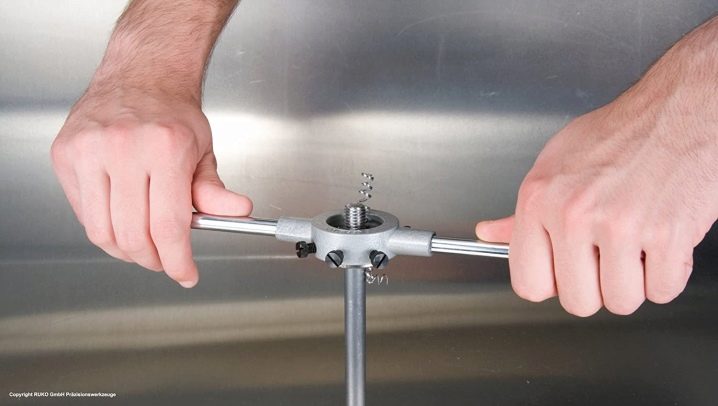
What it is?
The thread cutting tool is designed in such a way that with its help the thread groove is cut manually or with the help of a special machine. For mechanized cutting, you can use a drill or screwdriver that works at low speeds and gradually, without jerking. The die can have a collapsible design, the die can not be disassembled into two halves, since on one or both sides it has a solid element with a hole and grooves around the central axis (in the center) of the tool.
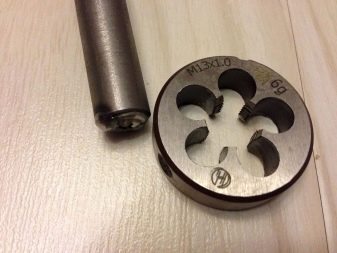

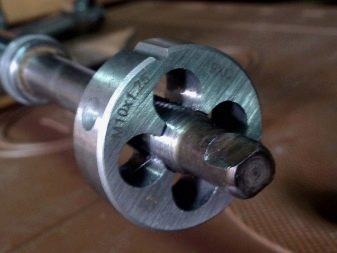
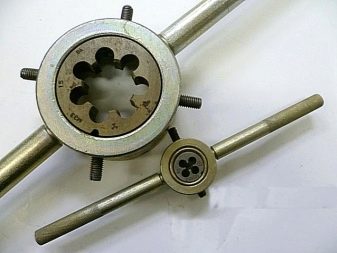
Dies and sticks today are essentially one and the same. In the past, the lerka was classified as a precision threading tool. In fact, this is a center-axial nut made of very hardened steel with cutting properties - with its help it is easy, for example, to make a threaded channel on a workpiece from a simpler, unhardened and low-alloyed, low-carbon steel St3. A sample for cutting a threaded groove is a piece of smooth cold-rolled reinforcement M10 made from this steel.
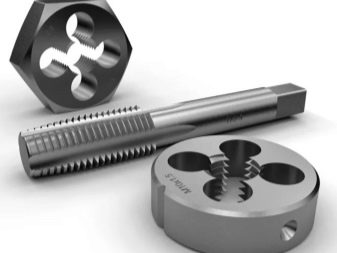
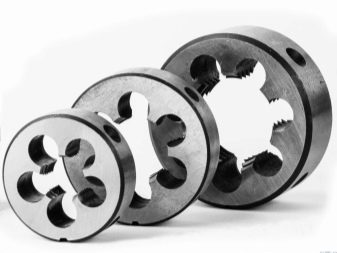
Views
The thickness of the die is equal to the height of approximately 8 turns of the threaded channel, which, following its edges, it leaves on the workpiece. It is designed in such a way that, in fact, each spiral turn undergoes about 6-8 passes, with the exception of the latter in the same number, beyond which the thread is not cut according to the drawing of the fastener. The intake part is only 3 turns out of 8.
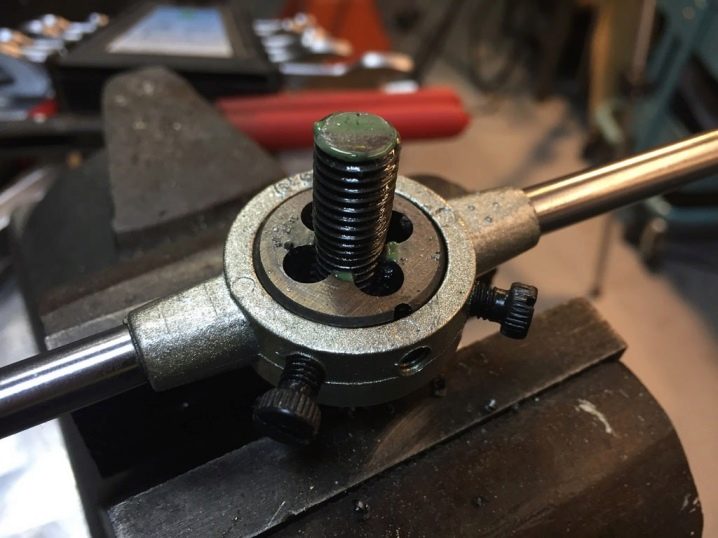
By design
Cutting (with a cut), solid and sliding cutting products are produced. The incision in the former runs from one of the sides - in fact, this is a through cut in this consumable. The sliding ones have two separable elements, completely identical in size and execution of turns inside the tool. To use them, you need a special holder into which they are inserted - a klupp. Solid ones do not represent any peculiarities - they are practically cast, solid drilled and solid cut. Between the cutting inner ends, aligned along the turns, which, in turn, are formed on a workpiece made of high-speed steel when cutting with a diamond tap in factory (conveyor) conditions, there are technological holes for removing chips from the workpiece being processed.
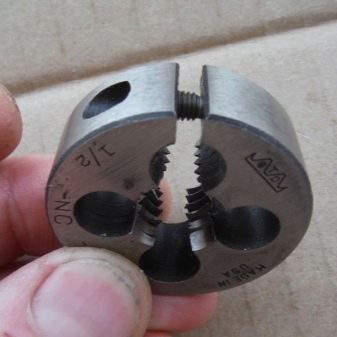
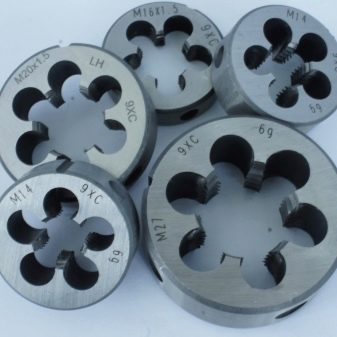
In the direction of the thread
The external (external) thread has a direction that coincides with the required one: for most structures fixed in a stationary way, a right-hand thread is used. An example is a U-shaped case for a homemade audio power amplifier, in which the printed circuit board and the walls of the case itself are fixed with bolts or screws, screws with a right-hand thread. Such a thread is cut - just as the screw itself, a bolt or a screw is tightened - clockwise. The nuts are screwed onto the bolts in the same direction.
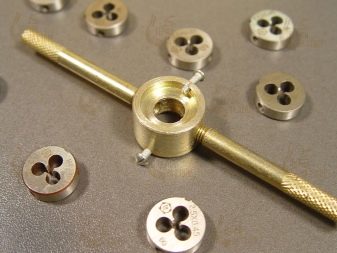
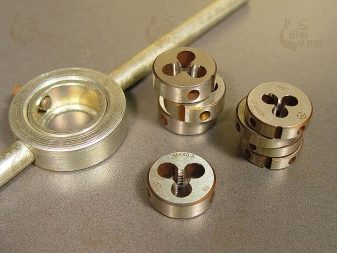
For rotating parts, mechanisms, bolts and pins are used, axles with a left-hand thread. The fact is that when a wheel, roller or pulley rotates (together with ball-bearing slippage), the thread must be left-handed, and when rotating to the left, right.If you neglect this rule, then on a racing sports car (bolide), after passing a few hundred meters, the wheels will simply spin and fly off, and the driver will be injured in an accident. A similar approach is used for all wheeled vehicles, up to bicycles and electric scooters.
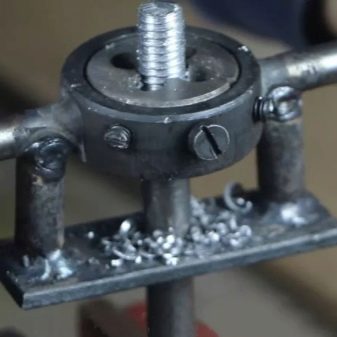
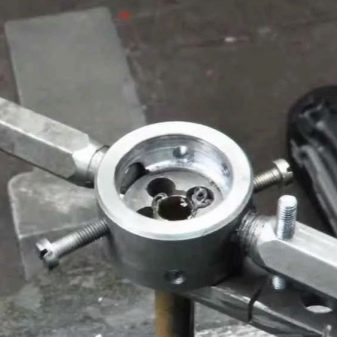
For this purpose, for example, for cutting M14 studs for a bicycle hub, dies for M14 with left and right types of internal threads are used equally. They do the same with taps - in them the external (external) thread, like the internal one for the dies, is used in the left and right directions. In the latter, a screw is cut for counter- and terminal nuts, threaded connectors-holders. All these parts form a single one-piece mechanism in the bicycle hub, which has a smooth and even ride without any backlash when riding this vehicle. You cannot do without dies and taps in the production of drive parts, gearboxes and type-setting bushings.
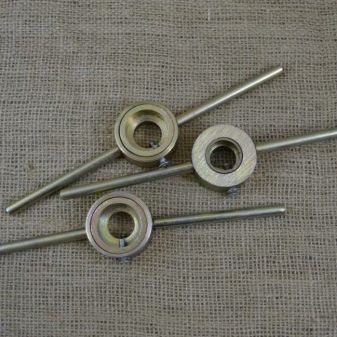
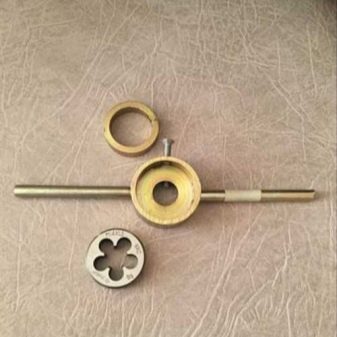
By profile
Profile threads can be regular and tapered, metric and inch. The cutting inner ends of simple dies are located with an equal offset of the turns from each other relative to the central axis. In conical ones, they have some convergence - if you draw a plane along the turns, as if rolled into a cone and converging at a certain point, like a bag for seeds, rolled up from a sheet of paper by hand. According to the profile design, in addition to round (flat-cylindrical), there are six-sided, square, prismatic ram cutters. The square and hexagonal ones do not need to be held with screws screwed into the locking fastening holes, in which a threaded groove is cut for the same screws.
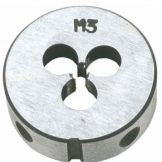


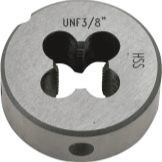
In the holder, sharp-cut dies, in contrast to the "edgeless" (round) dies, are fixed rigidly and without any additional attachment. It is only important that the ram holder itself has a perfectly centered free space (recess) into which the ram consumable is inserted. For convenience, the die holder - so that the die easily goes into it and does not fall out during operation - is supplemented with a magnetic blank, similar to the one used in a car holder for a cell phone, which has a case with a regular steel plate sewn into the back.

The non-magnetic faceted die holder allows you to fix a one-piece or split die due to a special lock, in which there is a passage for the workpiece being processed (cut), but the die cutter itself is held very reliably. An experienced craftsman can make any die holder for the dies he has, having a lathe and milling machine at hand.

Materials (edit)
In addition to wooden dies, which, as you know, can only be carved on soft plastic, paraffin and other materials with only a slight hardness, on sale there are copies of high-speed steel with alloying additives: 9ХС, ХВСГФ, Р18, Р6М5, Р6М5К5, Р6М5К8 and their foreign analogues. Dies made, for example, of bronze, allow cutting copper, from ordinary medium-carbon, high-alloyed (including stainless products) - aluminum, tin, lead, low-melting alloys. True, the manufacture of a helical (spiral) groove on soft and heavy metals is an exceptional rarity, for example, lead fasteners in nuclear reactors, where it is important to maximally absorb radiation that spreads everywhere.




Steel material - 9ХС - is not always indicated: it is believed that some manufacturers use this alloy by default, unless the customer-customer prescribes otherwise in the technical order.
Victory and diamond dies are not available commercially. They are produced mainly for workshops, in which, for example, there is equipment for the self-production of parts that have long been out of production and it is no longer possible to find them officially.Auto locksmiths and bicycle mechanics, working as IP, acquire thread cutters made of materials that significantly exceed the cutting steel grades in hardness and strength, but such cases are very individual. However, manufacturers of simple high-speed (steel) ram cutters and taps can purchase victorious and diamond dies from each other. For example, a HSS tap is cut with just such a ram cutter. And vice versa: the HSS is “cut” with a diamond or victory tap.

The usual consumer is offered mainly ram (lorchny) consumables from any (fast) cutting steel. The disadvantage of conventional steel dies is the inability to cut a thread, for example, on a hardened steel wire with a diameter of 3-4 mm: in spite of the lubrication, they will immediately become dull, although they are themselves hardened. However, with any non-ferrous metal, low- and medium-carbon, low- and medium-alloyed grades of steel, high-speed dies can easily cope with. The resource of this option is from a thousand to hundreds of thousands of turns of the finished thread.


Dimensions (edit)
Before considering the size, understand the labeling of the solid products.
- Marker "M" means that the thread is metric. For example, M-24-2 indicates a 24-gauge metric thread with a 2 mm spacing between the threads of the threaded groove. Metric dies have a 60-degree angle of the edge left after extrusion of excess steel from the workpiece - along the entire length of the spiral-screw pass of the die.

- "G" - inch thread, is mainly used for cutting pipe sections. G-1⁄2 - Threading tool for half-inch pipe. 1⁄2, 3/4, 1, 2 and 3 inch dies are the most common - they are used for water supply systems in apartments and country houses. Thread cutting angle - 55.

- LH - left-hand thread of dies. Such a consumable tool is in demand in the production of mechanisms in which threaded axles (hubs) are used.

- "K" - type of dies is used mainly for tapered threaded products. Billets (pipes, pins) have a variable diameter from the beginning to the end of the segment (butting), while it is possible that the split die is slightly springy, changing the working diameter by a fraction of a millimeter. The vertex angle is 60.

- "TR" - trapezoidal dies. They are used for cutting thread grooves on special-purpose parts. "BSW" or "BSF" - inch dies with a 55 degree edge angle. The UNC / UNF mark corresponds to the threading of the unified thread according to the state standard and international regulations of the United States. The angle of the threaded groove is 60.

For the diameters of the cut threads M6, M8, M10, M12, M16 and M20, the tolerances of a smooth pin are applied, respectively, 5.80 ... 5.95, 7.75 ... 7.90, 9.70 ... 9.95, 11.80 ... 11 , 95, 15.80 ... 15.95 and 19.80 ... 19.95 mm. It is not recommended to take an exact correspondence to the diameter of the pin for a standard size - for example, 20 mm for M20 - it is not recommended: the thread is cut more slowly, the cutter goes tighter, more lubrication is required, a slight inaccuracy of the threaded groove appears. The tool, in turn, overheats more - and wears out faster.

Of the standard sizes in the domestic market, 1/2 and 3/4 inch denominations are widespread. Millimeter sizes of metric dies - M6, M10, M8, M16, M3, M7, M24, M4, M12, M2, M16x2, M5, M20.
Assistive devices
For ram cutters, two hand elements are required: a metal ram holder and the same wrenches for it. The latter are screwed into the former with the help of special locking holes. In cheaper specimens that do not have threaded mounting holes, non-threaded fasteners are used, which can be improved by welding these wrenches to the die holder. The holes for the wrenches in the die holder are made blind.Craftsmen working with hardening of steels of various grades do without a die holder - they weld the wrenches directly to the die and re-harden the tool. In some cases, having at hand a Chinese die of questionable hardening, it can be re-hardened, somewhat improving its cutting properties.

To cut thread grooves on a large number of long studs, it is advisable to use a drive with a special long-gap ram holder, in which there is a reserve for the entry of the workpiece for the threaded passage being executed inside the pin being processed (or pipe section). An option is possible when the workpiece (pipe, pin) is automatically pushed by means of guides and a pusher - and is kept from turning (together with an automatic puller) by a special gripper. The cartridge ram holder clamps the ram cutter, into which the end face of the workpiece is inserted, which has been previously sharpened to a distance equal to one or two turns. The engine (drive, gearbox) is switched on at low, but gradually increasing speeds (up to a certain limit).
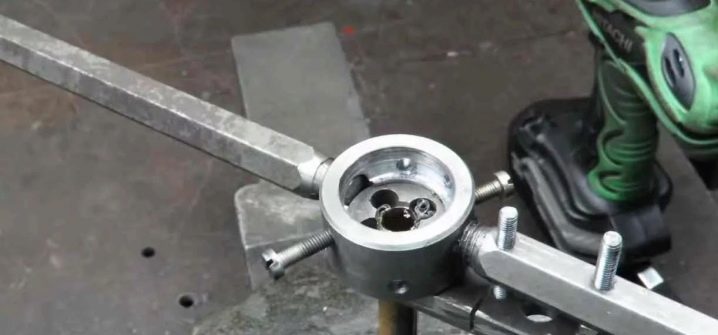
Industrial or engine oil is periodically fed to the workpiece itself and the cutter to prevent overheating of the ram cutter and the workpiece itself. The work can be carried out by the operator of such a machine by means of manual control. For full automation on the threading machine, a microcontroller is used that operates on the principle of CNC operation: the engine automatically starts and brakes, and oil is supplied at regular intervals. After processing one or more workpieces, cleaning of the working machine from chips is required: this function is performed by both the maintenance personnel of the conveyor and a technical (construction) vacuum cleaner paired with such a machine.

How do I use the tool?
If a conveyor or threading machine is still not needed, then use the simple rules that are true for manually cutting a pipe or pin.
- Grind the ends, from which you plan to cut the thread, for a gap length of 1-2 turns.
- Lubricate the lerka and the workpiece with technical oil.
- Install the ram into the die holder.
- Install the wrenches on the ram holder itself.
- Secure the workpiece in a vise.
- Place the die holder on the sharpened and oiled end to be machined and begin to rotate the tool with smooth jerks. After each rotation of the die by half a turn, roll it back so that the chips come out more easily and the tool is less worn out.
- After passing a few turns of the groove to be cut, screw the die off the workpiece to remove the chips. Then re-lubricate the scraper and the workpiece - and continue cutting until the required section of the pipe or pin has been passed.
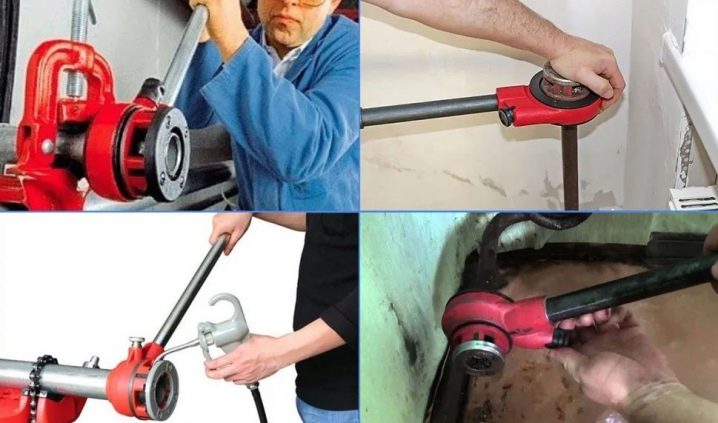
Cold rolled steel is slightly easier to thread than hot rolled steel. This is due to the ideal smoothness of the "cold wire rod", which is not possessed by hot-rolled steel parts.
For information on how to use it correctly with a plate, see the next video.









The comment was sent successfully.